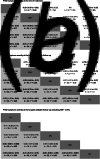Comparative efficacy and acceptability of expressive writing treatments compared with psychotherapy, other writing treatments, and waiting list control for adult trauma survivors: a systematic review and network meta-analysis
- PMID: 33634766
- PMCID: PMC9772920
- DOI: 10.1017/S0033291721000143
Comparative efficacy and acceptability of expressive writing treatments compared with psychotherapy, other writing treatments, and waiting list control for adult trauma survivors: a systematic review and network meta-analysis
Abstract
Background: Expressive writing about a traumatic event is promising in treating posttraumatic stress disorder (PTSD) symptoms in adult trauma survivors. To date, the comparative efficacy and acceptability of this approach is uncertain. Therefore, we aimed to examine the comparative efficacy and acceptability of expressive writing treatments.
Methods: We included 44 RCTs with 7724 participants contributing 54 direct comparisons between expressive writing (EW), enhanced writing (i.e. including additional therapist contact or individualized writing assignments; EW+), PTSD psychotherapies (PT), neutral writing (NW), and waiting-list control (WL).
Results: EW, EW+, PT, and NW were statistically significantly more efficacious than WL at the longest available follow-up, with SMDs (95% CI) of -0.78 (-1.10 to -0.46) for PT, -0.81 (-1.02 to -0.61) for EW+ , -0.43 (-0.65 to -0.21) for EW, and -0.37 (-0.61 to -0.14) for NW. We found small to moderate differences between the active treatments. At baseline mean PTSD severity was significantly lower in EW+ compared with WL. We found considerable heterogeneity and inconsistency and we found elevated risk of bias in at least one of the bias dimensions in all studies. When EW+-WL comparisons were excluded from the analyses EW+ was no longer superior compared with EW.
Conclusions: The summarized evidence confirms that writing treatments may contribute to improving PTSD symptoms in medium to long-term. Methodological issues in the available evidence hamper definite conclusions regarding the comparative efficacy and acceptability of writing treatments. Adequately sized comparative randomized controlled trials preferably including all four active treatment approaches, reporting long-term data, and including researchers with balanced preferences are needed.
Keywords: (partial) PTSD; PTSD symptoms; comparative efficacy; expressive writing; network meta-analysis.
Figures




Similar articles
-
Expressive writing treatments to reduce PTSD symptom severity and negative alcohol-related outcomes among trauma-exposed sexual minority women and transgender/nonbinary people: Study protocol for a mixed-method pilot trial.Contemp Clin Trials Commun. 2023 Aug 21;35:101197. doi: 10.1016/j.conctc.2023.101197. eCollection 2023 Oct. Contemp Clin Trials Commun. 2023. PMID: 37671246 Free PMC article.
-
Effects of expressive writing intervention for women's PTSD, depression, anxiety and stress related to pregnancy: A meta-analysis of randomized controlled trials.Psychiatry Res. 2020 Jun;288:112933. doi: 10.1016/j.psychres.2020.112933. Epub 2020 Apr 14. Psychiatry Res. 2020. PMID: 32315889 Review.
-
Comparison of eye movement desensitization and reprocessing therapy, cognitive behavioral writing therapy, and wait-list in pediatric posttraumatic stress disorder following single-incident trauma: a multicenter randomized clinical trial.J Child Psychol Psychiatry. 2017 Nov;58(11):1219-1228. doi: 10.1111/jcpp.12768. Epub 2017 Jun 28. J Child Psychol Psychiatry. 2017. PMID: 28660669 Clinical Trial.
-
Examination of moderators of expressive writing in patients with renal cell carcinoma: the role of depression and social support.Psychooncology. 2017 Sep;26(9):1361-1368. doi: 10.1002/pon.4148. Epub 2016 May 3. Psychooncology. 2017. PMID: 27145447 Free PMC article. Clinical Trial.
-
Interventions for adults with a history of complex traumatic events: the INCiTE mixed-methods systematic review.Health Technol Assess. 2020 Sep;24(43):1-312. doi: 10.3310/hta24430. Health Technol Assess. 2020. PMID: 32924926 Free PMC article.
Cited by
-
Exploring the Therapeutic Role of Coach-Guided Videoconferencing Expressive Writing in Multiple Sclerosis: A Qualitative Study.Healthcare (Basel). 2025 May 9;13(10):1104. doi: 10.3390/healthcare13101104. Healthcare (Basel). 2025. PMID: 40427941 Free PMC article.
-
Resilience in the Face of War: a Collaborative Autoethnography of a Ukrainian Refugee Student's Journey through Europe Striving to Find Oneself.Acta Med Acad. 2024 Dec;53(3):352-372. doi: 10.5644/ama2006-124.462. Acta Med Acad. 2024. PMID: 39720881 Free PMC article.
-
Expressive writing treatments to reduce PTSD symptom severity and negative alcohol-related outcomes among trauma-exposed sexual minority women and transgender/nonbinary people: Study protocol for a mixed-method pilot trial.Contemp Clin Trials Commun. 2023 Aug 21;35:101197. doi: 10.1016/j.conctc.2023.101197. eCollection 2023 Oct. Contemp Clin Trials Commun. 2023. PMID: 37671246 Free PMC article.
-
An Evidence-Based Approach for Treating Stress and Trauma due to Racism.Cogn Behav Pract. 2023 Nov;30(4):565-588. doi: 10.1016/j.cbpra.2022.07.001. Epub 2022 Aug 24. Cogn Behav Pract. 2023. PMID: 38037647 Free PMC article.
-
Trauma writing reduces conserved transcriptional response to adversity (CTRA) gene expression: A culturally adapted pilot study.Compr Psychoneuroendocrinol. 2025 Jul 14;23:100310. doi: 10.1016/j.cpnec.2025.100310. eCollection 2025 Aug. Compr Psychoneuroendocrinol. 2025. PMID: 40718431 Free PMC article.
References
-
- *Alessandri, F. T. (2017). Testing a brief directive intervention to reduce symptoms associated with trauma. Dissertation Abstracts International: Section B: The Sciences and Engineering.
-
- American Psychiatric Association. (2013). Diagnostic and statistical manual of mental disorders (DSM-5®). Washington, DC: : American Psychiatric Pub.
-
- American Psychological Association. (2017). Clinical practice guideline for the treatment of posttraumatic stress disorder (PTSD) in adults. Retrieved from https://www.apa.org/about/offices/directorates/guidelines/ptsd.pdf.
-
- Andersson, M. A., & Conley, C. S. (2008). Expecting to heal through self-expression: A perceived control theory of writing and health. Health Psychology Review, 2, 138–162. doi: 10.1080/17437190802660890. - DOI
LinkOut - more resources
Full Text Sources
Other Literature Sources

